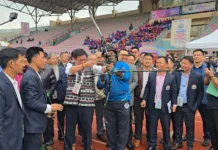[ Milli Bharat ]
The proposed Kamala Hydroelectric Project (KHEP) – planned on the Kamala river in Kamle district and expected to generate nearly 1,800 MW – is being hailed by the Centre as a major step towards India’s energy security. But for the people of Kamle district, especially the project-affected families (PAFs), the project has triggered deep unease about their future, their rights, and the very meaning of ‘development’.
Lives on the line
Hundreds of families stand to lose ancestral homes, fertile terraces, grazing grounds and community forests. For them, land is not an economic asset; it is food security, culture and identity. One-time compensation cannot replace the soil that has sustained generations. Nor can it restore the social networks and cultural rhythm tied to the Kamala river.
The influx fear
Residents also dread the influx of outside labourers during construction. Past experience across India shows that such inflows often sideline local workers, inflate rents and strain sanitation and healthcare. Without local-hire clauses and proper regulation, a project meant to empower may instead alienate the very people living beside it.
Noise, dust and anxiety
Blasting, heavy machinery and 24-hour vehicle movement will shatter the stillness of this remote district. Villagers worry about noise pollution, disturbed schooling and sleepless nights. More frightening is the psychological fear of dam failure- a constant anxiety magnified during monsoons, when every tremor or rumour rekindles panic. These invisible costs rarely appear in official reports.
Rising clan tensions
The race for compensation and land surveys has already revived boundary disputes among clans and villages. Unless the state creates transparent mediation mechanisms, today’s development push could tomorrow fuel inter-community conflict.
A pattern of regressive projects
History offers sobering lessons. The Sardar Sarovar and Tehri dams displaced thousands who are still awaiting full rehabilitation. The Lower Subansiri project remains stalled after years of protest over safety and environmental concerns. In the Northeast itself, projects like Dibang and Siang have faced similar opposition. Each case shows how hasty clearances and token consultations create enduring scars.
An over-dammed state
Arunachal Pradesh is now dotted with dozens of planned or approved hydropower schemes. Every major and minor river – from the Siang to the Subansiri, Dibang and Kamala – is being earmarked for dams. Many here believe the state is being treated as a resource frontier for the national grid, while the environmental, cultural and psychological costs are borne locally. It raises a hard question: does this relentless dam drive honour the spirit of India’s Constitution, which guarantees special protection and self-determination for tribal states under Article 371H and allied laws?
Rights ignored, voices excluded
Under the Forest Rights Act (2006) and land-acquisition laws, tribal communities are entitled to informed consent, fair compensation, and rehabilitation before any forest diversion. In practice, hearings are often perfunctory, held in unfamiliar languages, and devoid of transparency. The result is consent in name, not in spirit.
The questions the government must answer
Before construction begins, the state and NHPC must clearly tell citizens:
- Have all community and individual forest rights been settled and recorded under the FRA?
- Will the full project report, environmental and social impact assessments be made public in local languages?
- What guarantees exist for local employment, safety drills, and long-term livelihood restoration?
- How will boundary disputes and mental health impacts be addressed?
- What cumulative impact study covers the many dams planned across the Kamala-Subansiri basin?
Until these questions are answered with evidence -not promises – proceeding would be an act of negligence.
Development must begin with dignity
No one in Kamle rejects progress. The residents only demand that progress respect dignity, transparency and justice. Hydropower can light cities, but it must not darken the lives of those who live by the rivers. Development measured only in megawatts, not in human wellbeing, is not development at all.
If the government truly believes this project serves the public good, it must first prove that no family will be worse off because of it. Otherwise, the Kamala hydro project will stand not as a monument of progress, but as another reminder of how easily the voices of the smallest communities are drowned by the roar of big dams. (The contributor is pursuing MA in economics at the Delhi School of Economics)

